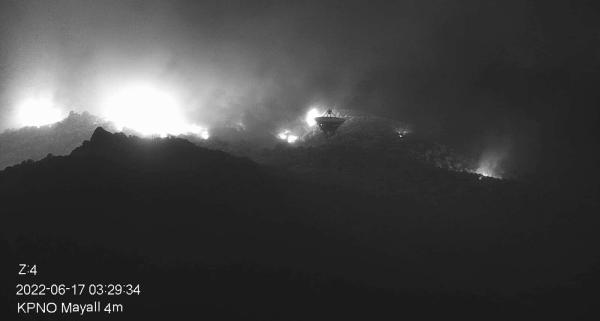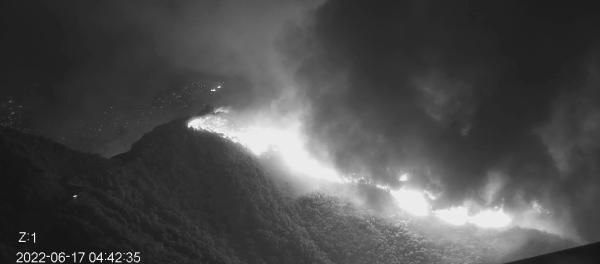The Contreras Fire has raged through the mountains of Arizona since June 11. In the early morning of June 17, local time in the United States, the fire had spread to the Kitt Peak National Observatory (KPNO), threatening some of the observatory's telescopes. According to the latest news, one of the 12-meter radio telescopes may have been damaged. 
The Kitt Peak National Observatory was established in 1958 and is located in the Tucson Mountains of Arizona, USA. The observatory is operated by the National Optical Infrared Astronomy Research Laboratory (NOIRLab) of the National Science Foundation.
NOIRLab said in a release that the fire started on a remote ridge in the Babo Kivari Mountains south of the Kitt Peak National Observatory. The fires were started by lightning strikes, and the region's mountainous terrain, high winds, and dry vegetation intensified the fires, making firefighting difficult. The Contras Fire has burned nearly 11,500 acres as of June 16, and shows no signs of slowing, according to the Arizona Emergency Information Network.
To prevent the fire from spreading to the observatory facility, dry brush and trees were removed from the southern ridge, according to a press release from the local weather station. Likewise, planes sprayed flame retardants in the area, and power to the observatory was cut off on the morning of June 17. At 2 a.m. on the 17th, the fire swept through the southwest ridge, threatening 4 telescopes: including the Hiltner 2.4-meter telescope, the McGraw-Hill 1.3-meter telescope, the Very Long Baseline Array Dish The VLBA and the University of Arizona's 12-meter radio telescope. The latter is managed by the University of Arizona and is part of the Event Horizon Telescope. The first image of a black hole and the latest image of the black hole at the center of the Milky Way are produced from the observation data of the Event Horizon Telescope.
According to a report by observatory staff on DESI's Slack channel, who monitored the fire through five webcams outside the Mayall telescope dome, what they saw was, "The University of Arizona's 12-meter radio telescope may have Damaged; nearby VLBA antenna surrounded by fire; broken webcam on Hiltner's 2.4m telescope, which is currently blocked by fireworks."

Google Maps shows the telescopes are about 3,000 feet (0.9 kilometers) from the observatory's other facilities.
"The Observatory is working with firefighters on site to assess the possible damage," NOIRLab said in a press release. "We will share details about the facility when more information is known. We are still in a rapidly changing fire situation."
Temperatures in the Tucson area have reached 40°C (105°F) over the past few days. Partly cloudy with scattered showers and thunderstorms is expected on June 18.
This year's fire season started earlier than usual in the western United States after New Mexico suffered the largest wildfires on record in the state. Climate change has led to more frequent heatwaves and droughts, which were important initial factors in recent wildfires in Arizona, New Mexico and Texas.
The Kitt Peak National Observatory is located on the summit of Kitt Peak, 90 kilometers southwest of Tucson, Arizona, USA. It is 2096 meters (6880 feet) above sea level and is part of the National Optical Astronomy Observatory (NOAO). The site is located in the Qumran Mountains of the Sonoran Desert, which attracts astronomers for its clear weather, stable atmosphere and low humidity.
The observatory's main research facilities include 3 main night telescopes, as well as 22 optical telescopes. In addition to the four telescopes that have been threatened by wildfires this time, the observatory also includes a 4-meter-diameter Mayer telescope, a 3.5-meter-diameter WIYN telescope, and a 2.1-meter, 0.9-meter, and 0.4-meter reflector telescope. , and the world's largest solar telescope, the McMess-Pearce Solar Telescope, affiliated with the National Solar Observatory.

The Kitt Peak National Observatory was established in 1958 and is located in the Tucson Mountains of Arizona, USA. The observatory is operated by the National Optical Infrared Astronomy Research Laboratory (NOIRLab) of the National Science Foundation.
NOIRLab said in a release that the fire started on a remote ridge in the Babo Kivari Mountains south of the Kitt Peak National Observatory. The fires were started by lightning strikes, and the region's mountainous terrain, high winds, and dry vegetation intensified the fires, making firefighting difficult. The Contras Fire has burned nearly 11,500 acres as of June 16, and shows no signs of slowing, according to the Arizona Emergency Information Network.
To prevent the fire from spreading to the observatory facility, dry brush and trees were removed from the southern ridge, according to a press release from the local weather station. Likewise, planes sprayed flame retardants in the area, and power to the observatory was cut off on the morning of June 17. At 2 a.m. on the 17th, the fire swept through the southwest ridge, threatening 4 telescopes: including the Hiltner 2.4-meter telescope, the McGraw-Hill 1.3-meter telescope, the Very Long Baseline Array Dish The VLBA and the University of Arizona's 12-meter radio telescope. The latter is managed by the University of Arizona and is part of the Event Horizon Telescope. The first image of a black hole and the latest image of the black hole at the center of the Milky Way are produced from the observation data of the Event Horizon Telescope.
According to a report by observatory staff on DESI's Slack channel, who monitored the fire through five webcams outside the Mayall telescope dome, what they saw was, "The University of Arizona's 12-meter radio telescope may have Damaged; nearby VLBA antenna surrounded by fire; broken webcam on Hiltner's 2.4m telescope, which is currently blocked by fireworks."


The above two images are images of astronomers around the telescope on the southwest ridge seen through the Mayall telescope
Google Maps shows the telescopes are about 3,000 feet (0.9 kilometers) from the observatory's other facilities.
"The Observatory is working with firefighters on site to assess the possible damage," NOIRLab said in a press release. "We will share details about the facility when more information is known. We are still in a rapidly changing fire situation."
Temperatures in the Tucson area have reached 40°C (105°F) over the past few days. Partly cloudy with scattered showers and thunderstorms is expected on June 18.
This year's fire season started earlier than usual in the western United States after New Mexico suffered the largest wildfires on record in the state. Climate change has led to more frequent heatwaves and droughts, which were important initial factors in recent wildfires in Arizona, New Mexico and Texas.
The Kitt Peak National Observatory is located on the summit of Kitt Peak, 90 kilometers southwest of Tucson, Arizona, USA. It is 2096 meters (6880 feet) above sea level and is part of the National Optical Astronomy Observatory (NOAO). The site is located in the Qumran Mountains of the Sonoran Desert, which attracts astronomers for its clear weather, stable atmosphere and low humidity.
The observatory's main research facilities include 3 main night telescopes, as well as 22 optical telescopes. In addition to the four telescopes that have been threatened by wildfires this time, the observatory also includes a 4-meter-diameter Mayer telescope, a 3.5-meter-diameter WIYN telescope, and a 2.1-meter, 0.9-meter, and 0.4-meter reflector telescope. , and the world's largest solar telescope, the McMess-Pearce Solar Telescope, affiliated with the National Solar Observatory.



Comments